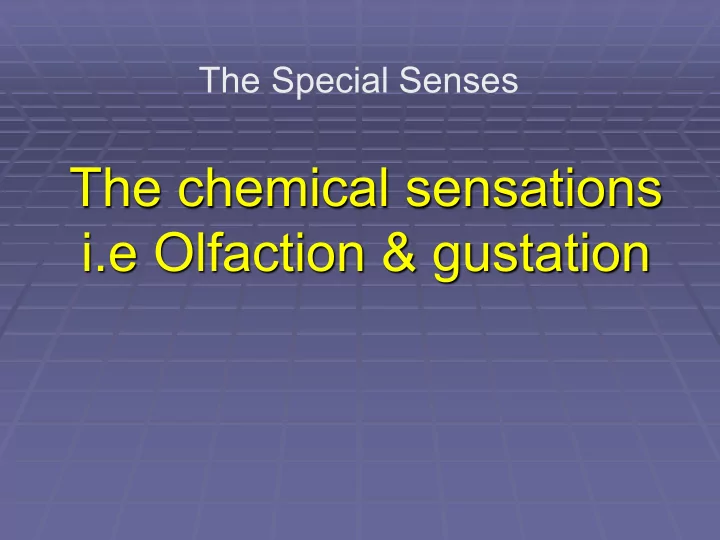

The Special Senses The chemical sensations i.e Olfaction & gustation
Definitions Olfaction: The ability to sense odors through the detection of substances which have been aerosolized into the environment. Gustation: The sensation which is produced by the interaction of taste receptors with solubilized chemical stimuli in the oropharyngeal cavity.
Olfactory System
Olfactory Epithelium containing 3 main cell types: • Olfactory receptor neurons • Supporting cells • Basal cells
nerve
nerve
Olfactory Bulb (feedback and adaptation) • Five well-defined layers of cells & fibers, which give a laminated appearance • Olfactory nerve layer • Glomerular layer • External plexiform layer • Mitral cell layer • Granule cell layer Important Points • Olfactory receptor neuron axons converge to synapse on the apical dendrites of mitral, tufted, and periglomerular cells in core regions of the glomerular layer known as glomeruli • Mitral and tufted cells form the efferent projection from the olfactory bulb
glomerulus nerve
Projections of Olfactory Bulb Axons leaving the olfactory bulb project to the anterior olfactory nucleus Or Travel via the lateral olfactory stria to the olfactory cortex on the ventral surface of the telencephalon Olfactory cortex lies adjacent to the olfactory trigone: the triangle-shaped area at the intersection of the olfactory tract, lateral and medial olfactory stria and olfactory tubercle.
Associational Connections
Primary Olfactory cortex Inferior and medial surface of temporal lobe
Disorders of the Olfactory System Anosmia/Hyposmia: Loss/decreased sensitivity to odorants. Access of odorants to olfactory epithelium is blocked. Edema of olfactory epithelium. Ex. Upper respiratory infections, sinus disease. Head Trauma Ex. Shearing movement of olfactory bulb relative to cribriform plate. Boxers- transection of olfactory receptor axons in passage. Nasal polyps
The Gustatory System
Taste receptors ( taste buds)
Regional Specialization for the Detection of Different Taste Qualities ? 5 • Umami: a recently described taste sensation for meaty sensation, that exemplifies the 1 taste of monosodium glutamate & is important in the 2 identification of amino acids. 3 4 (Kandel, Schwartz & Jessup: Principles of Neural Science 3 rd ed. Fig. 34-8) All taste qualities are detected in all regions of the tongue, although sensitivity to the different taste qualities may vary by region
Taste pathway
Taste pathway
Lingual Taste Buds
Nucleus of the Solitary Tract Solitary tract
Disorders of Taste Ageusia: Complete loss of taste. Hypoageusia: Decreased taste sensitivity. Examples: Cancer patients undergoing radiation or chemotherapy. Medications. Progressive loss of taste in diabetic patients.
Flavor
Taste smell interaction Although anatomically distinct systems, the modalities of taste and smell work well together Flavor: Incorrectly mistaken as taste A sensory experience which results from the combination of olfactory and taste, somatosensory, and visual cues. Olfaction >>>>> taste potent
insular cortex and orbitofrontal cortex The medial orbitofrontal cortex & lateral posterior orbitofrontal cortex play an important role in integrating olfactory, taste, and other food- related cues that produce the experience of flavor
Recommend
More recommend